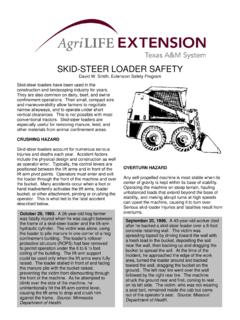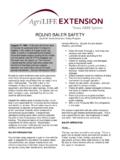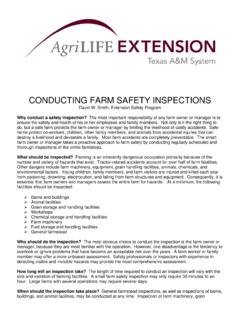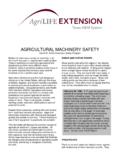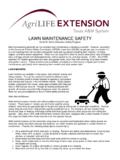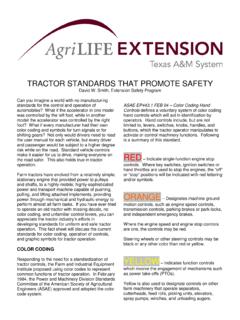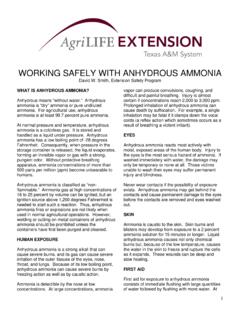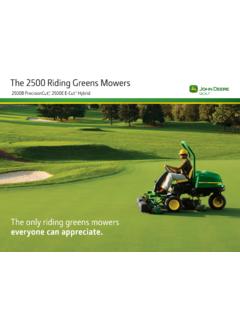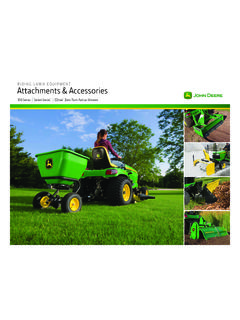Transcription of LAWN MAINTENANCE SAFETY
1 lawn MAINTENANCE SAFETY David W. Smith, Extension SAFETY Program Most homeowners generally do not consider lawn MAINTENANCE a dangerous activity. However, according to the Consumer Product SAFETY Commission (CPSM), more than 230,000 people per year are treated for injuries resulting from various lawn and garden tools and equipment including lawn mowers , trimmers, edgers, and other power equipment. These injuries range from minor to severe lacerations, loss of fingers, toes, and legs, broken and dislocated bones, mild to severe burns, and eye injuries. In 2001, the CPSM reported 167 deaths associated with lawn and garden tools; more than half involving riding lawn mowers and garden tractors.
2 These accidents are avoidable, provided you make SAFETY a regular part of lawn MAINTENANCE , particularly when operating lawn mowers and other power tools. lawn mowers lawn mowers are available in two types: walk-behind mowers and riding mowers . Though the method of control is different, both types of mowers present similar hazards to operators, bystanders, and animals that may be in the immediate vicinity. Rotary blades located underneath the mower rotate approximately 200 miles per hour or 300 feet per second. Though somewhat protected with guards, all mowers are potentially dangerous when the operator does not use good judgment or fails to follow SAFETY procedures.
3 Walk-Behind mowers Walk-behind mowers include both self-propelled and push-type mowers . These types of mowers are commonly used by young children, since they are generally light in weight and easy to manipulate in most lawn conditions. Several SAFETY features exist which help protect against accidental injury. For example, all new mowers have directional flaps or shielded discharge outlets that direct grass and any other projection from hitting the operator. Also, since 1978, walk-behind lawn mowers have been equipped with a clutch handle or switch that stops the blade within three seconds after the operator lets go.
4 Walk-behind mowers can be extremely dangerous to operators and bystanders when SAFETY guards are removed, SAFETY shut-down devices are disabled, and when mowers are operated in unsafe manner or environment. Practice the following SAFETY tips to prevent injury: Do a walk-through of the yard prior to mowing. Remove any debris and obstructions including toys, limbs, rocks, wire, or glass. Locate all sprinkler heads, exposed electrical wire or cords, tree stumps, or exposed roots and Keep hands and feet away from the blade area while the mower is running. Never reach underneath or into the discharge chute to clear away grass or other obstructions when the blades are turning.
5 Never bypass the engine kill handle or remove shields when mowing. Mow back and forth along the side of a steep hill, never up and down the slope. Don t direct the discharge chute in the direction of bystanders. Wear boots or shoes with good traction to avoid slipping and falling. Don t allow young children to operate a walk-behind mower that they cannot safely control. Be careful when refueling a hot engine. Use a funnel to avoid spilling fuel. Clean up any fuel spills immediately. Never smoke while servicing, operating, and refueling a mower. Wear proper protection against flying debris and noise (long pants, hard shoes, SAFETY glasses, ear plugs, etc.)
6 Allow the engine to cool before storing it in a storage shed. Turn the power off and disconnect the spark plug wire from the spark plug before cleaning, inspecting, adjusting, or repairing the cutting blade. Don t run a gasoline powered mower inside a storage shed; this could cause carbon dioxide poisoning. Never touch the spark plug with your hand or a tool when the mower is operating. Never leave a running mower unattended, especially when children are around. Don t mow a wet lawn . Losing control from slipping on rain-soaked grass is the leading cause of foot injury caused by power mowers .
7 When using an electric mower, keep the cord behind you. Trail it over your shoulder and mow away from the cord, never toward it. riding mowers riding mowers save homeowners valuable time and energy. These small tractors are much more powerful than walk-behind mowers and move two to three times as fast. Drivers should treat riding mowers as they would larger tractors, using safe driving techniques and SAFETY devices to avoid accidents. According to the CPSM, in 2001, more than 50 percent of 167 deaths associated with lawn and garden tools involved riding mowers agarden tracnd tors.
8 New riding mowers come equipped with seat SAFETY switches that stop the cutting blades from turning whenever the driver leaves the seat. Some riding mowers also have SAFETY interlocks that will not allow the mower to be started unless all controls are in proper position and the driver is in the seat. In addition to the SAFETY tips listed for walk-behind mowers , riding mower operators should take additional precautions. Don t allow extra riders. Test drive the mower, and become familiar with it before engaging the mower blade. Put the riding mower into neutral before starting it of shutting is off.
9 Watch out for holes and hidden hazards. Don t drive too close to a creek or ditch, and be mindful of any obstructions. Make sure the transmission is out of gear and the mower blade clutch is disengaged before starting the engine. Mow up and down sloping terrain. Do not mow across a slope. Keep the mower in gear when going down slopes. Slow down when turning and when working on slopes. Always look behind you before backing the mower. Disengage mower blade when on pavement, sidewalks or gravel lanes. Don t operate a riding mower when under the influence of alcohol or other drugs that impair judgment.
10 Don t let children play in the lawn where you are mowing; they could be struck by flying objects. Don t let children operate riding mowers until they can safely steer, brake, and adjust gears, and until they have had proper instruction. POWER TOOLS In addition to mowers , an assortment of power tools is available that helps us manicure and shape our landscapes. Electric and gas-powered weed trimmers, lawn edgers, hedge trimmers, and leaf blowers do the work that used to take days and many backaches to accomplish. However, this equipment is potentially dangerous and should be used with caution by those trained on how to use them safely.

